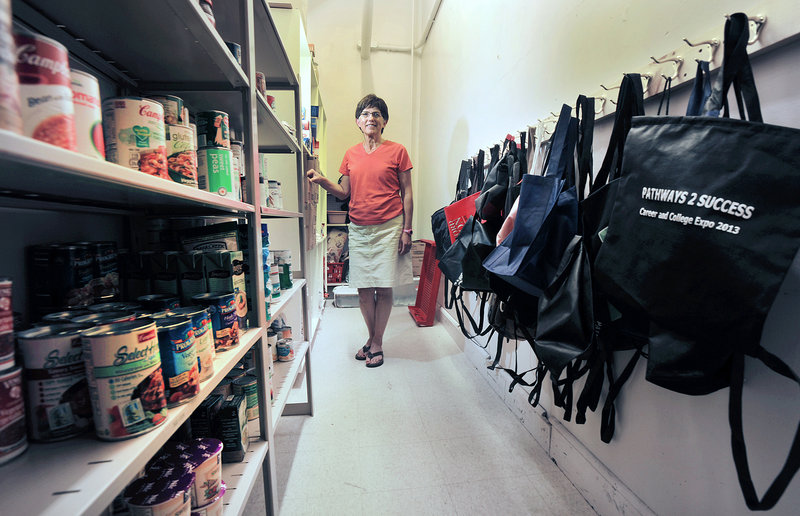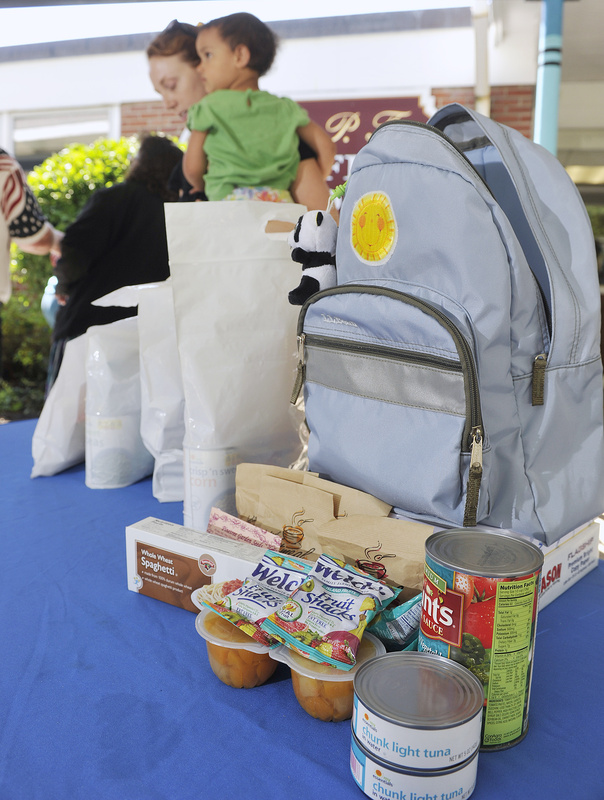BRUNSWICK — Programs to combat hunger will be more visible when Maine’s public schools open in a few weeks, part of a growing effort to get more food into the hands of hungry children and their families.
Eight schools in Maine will open with food pantries on school grounds, compared to none a year ago. Another program that provides needy students and their families with food to eat on weekends and school vacations, called the BackPack Program, has also expanded, officials say.
“If we target the children, we can break that cycle of poverty and hunger,” said Clara McConnell Whitney, communications manager for Good Shepherd Food-Bank.
An estimated one in four children in Maine is considered “food insecure,” meaning without a regular and reliable source of food. That is the highest rate in New England and 19th highest nationwide, according to the U.S. Department of Agriculture.
The Auburn-based nonprofit Good Shepherd Food-Bank, which supplies food for pantries and anti-hunger initiatives throughout the state, used a $25,000 grant to aggressively expand the Maine food pantry program, which was started at Portland High School last December.
Last school year, Good Shepherd Food-Bank’s school-based programs distributed nearly 70,000 meals to hungry children and their families. This year, the agency expects to more than double that figure to 200,000 meals to 1,250 students and their families through 39 schools.
The need for such anti-hunger programs is growing: More than 80,000 Maine children qualify for federally subsidized free or reduced-price meals at school. The school pantry and BackPack programs are aimed at filling in the gaps, to provide snacks during the day as well as food at night and on weekends at home. There is also a free meal program in the summer that operates in various locations around the state.
Katie Wallace, a parent volunteer at Portland’s East End Community School, started bringing in snacks after the first day she volunteered in her then-kindergartner’s class when she saw about six children who didn’t have anything to eat at snack time.
“For them to sit still for 15 or 20 minutes and watch their fellow students eat, it was excruciating. I couldn’t bear it,” said Wallace, a restaurant server and artist who wound up coordinating donated snacks for the children.
“Shame can be more debilitating than the lack of nutrition. This totally destigmatizes it,” she said.
She ran her volunteer snack program for more than two years before a grant from the Good Shepherd Food-Bank helped open a food pantry at the school to offer snacks to more students in need.
Wallace said hunger is a worse problem for younger children, who don’t know how to get food if it isn’t offered to them.
“One of the teachers told me that by about third grade, the students can figure out a way to get food – forage in their kitchens or find food – but kindergartners and first-graders don’t get it yet. They don’t know how to fend for themselves yet and they just show up empty-handed,” Wallace said.
Both the BackPack and School Pantry programs are modeled after programs run in other states by Feeding America, a national network of private food banks.
Nationwide, 25 food banks operated more than 400 School Pantry Program locations that served nearly 70,000 children in 2010, the most recent year for which data were available.
“We saw that this program was successful in other parts of the country,” Whitney said.
On Monday, Mid Coast Hunger Prevention Program announced it was partnering with Good Shepherd and would be expanding the Backpack Program further, providing food for about 200 students at eight elementary schools in the midcoast region.
Each backpack contains a protein, grain, fruit and vegetable, and the students know the menu ahead of time, according to Shannon Coffin, who oversees child hunger initiatives for Good Shepherd Food-Bank. Each backpack is limited to five pounds of food, so the youngest children can carry them home, she said.
“For so many of these kids, so little in their life is stable. We want them to know this is stable and (families) can plan their grocery shopping around it,” Coffin said. “When a family knows we’re giving them whole wheat pasta and a sauce, they know they can buy broccoli to stretch it.”
The first school pantry program in Maine was started at Portland High School by students in the Key Club, who approached Good Shepherd Food-Bank to create the pantry for fellow students – some of them homeless – who didn’t have enough to eat once they left school. In their initial effort, the students tried to raise the money and buy food themselves, but they weren’t able to sustain it.
“It was very unexpected for us” to launch the first school-based food pantry in the state, said Portland High math teacher Zarmina Hanifi, the adviser to the 120-member Key Club. “They are doing a great job.”
Employees at Good Shepherd trained the Key Club students on food safety, how to run a small food pantry and how to stretch their food dollars.
“It was really inspiring and just encouraging to see they had this idea first,” Whitney said.
Whitney said they monitored the Portland High pantry as a pilot case, to make sure it ran smoothly.
When it proved successful, the agency launched similar partnerships in other areas that have high rates of childhood hunger. One of the pantries was opened at East End Community School, where it replaced Wallace’s informal snack program.
For older students, a school pantry program can help them stay in school, Coffin said.
“It keeps teens from dropping out because they need to get jobs, or they need time to find social services, or they just need to eat,” she said.
By the end of last year, pantries were also operating at Indian Island School on Indian Island, Southern Aroostook Community School in Dyer Brook, Ashland District School in Ashland, Whitefield Elementary School in Whitefield and Wiscasset High School in Wiscasset.
In a few weeks, the newest food pantry will open at Edward Little High School in Auburn.
“One reason we’re excited about the school pantry model is it’s a way to reach families that have been traditionally difficult for the emergency food system to reach because they live in rural areas,” Whitney said. “It might be 20 miles to drive to the nearest food pantry, but their kids are going to school every day.”
Each school decides the best way to distribute the food, and the program is open to anyone. Teachers and guidance counselors often “just know” who needs help, Whitney said, whether the student is homeless, asks for food, or if a teacher notices the student doesn’t eat during the school day.
In some schools, teachers and guidance counselors work with needy students to distribute the food discreetly, to lessen the stigma.
In other schools, the monthly “drop-off” of food from Good Shepherd includes large amounts of fresh fruits and vegetables in addition to nonperishables, and the schools turn that drop-off into a farmer’s market-like experience for everyone to participate in – timed when parents are at the school to pick up their children.
Whitney said the organization is looking for funding to expand both the food pantry and BackPack programs further. In addition to major grants, smaller amounts can fund local efforts, Whitney said. For example, a local Dunkin’ Donuts franchise owner in the Auburn area provided the $5,000 needed to open the school food pantry at Edward Little High School.
Wallace said she thought the $5,000 grant to East End would sustain the program for about two years.
When she was buying snacks, it cost about $75 a week, she said. But working with Good Shepherd, $60 buys about two months’ worth of supplies for the school pantry.
“It’s been such a miracle,” she said. “Buying at cost, or by the pound, changed everything.”
Some of the school pantries in more rural areas got calls from residents asking if they could drop off canned goods in exchange for fresh produce, Coffin said.
“These people live so rurally, they don’t have access to fresh produce,” she said, adding that organizers told the callers to just come get the produce they needed without having to exchange it for canned goods.
“(The School Pantry program) really can change the health of a community,” she said.
Noel K. Gallagher can be contacted at 791-6387 or at:
ngallagher@pressherald.com
Send questions/comments to the editors.




